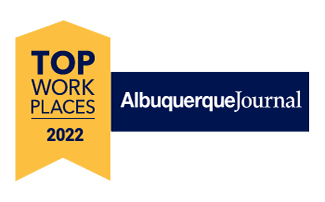
NMSBVI Programs - Family-Infant-Toddler Program.
The New Mexico School for the Blind and Visually Impaired (NMSBVI) provides statewide direct services to families of young children who have a diagnosed visual impairment or who are considered to be at risk for receiving a VI diagnosis. Services are a partnership with NMSBVI, New Mexico’s Family, Infant, Toddler Program (FIT) and the Navajo Nation; all children are served by IFSP team decision. Services are delivered in the family home or in another community environment that supports the child and his/her family.
Who should be referred to NMSBVI?
Any child between the ages of birth and three years old:
Any child who has been diagnosed with a vision impairment
Any child who has an established condition that places them at risk for vision impairment; Established conditions can include but are not
limited to: prematurity, syndromes, a family history of visual impairment, or traumatic events such as oxygen deprivation, meningitis,
or shaken baby syndrome
Any child whose family or team is concerned about some aspect of the child’s vision
Any child whose results on the New Mexico Vision Screening Tool indicate need for referral.
Who can make a referral to NMSBVI?
Anyone who has concerns about a child’s vision can, with the family’s permission, make a referral. Referrals can be made by calling 1-800-437-3505, extension 3066 or by calling the Developmental Vision Specialist responsible for an agency’s referrals. (Please see attached list of contacts by area of the state). List of specialists
What happens after a referral is made?
Within 48 hours of receiving a referral, a developmental vision specialist from NMSBVI will contact the family. An initial functional vision evaluation will be completed; eligibility will be determined and, in conjunction with the family and the child’s team, services will be outlined if recommended.
What services are available from NMSBVI for infants and toddlers?
Consultation to the family and/or community service providers, therapists, etc.
Direct services to the child and family;
Functional Vision Evaluations;
Developmental intervention strategies to support the development of visual/compensatory visual skills;
Information about blindness/visual impairment;
Referral and resource information for families;
Consultation/participation in agency assessments;
Participation in IFSP and other team meetings;
Orientation and Mobility Evaluations;
Orientation and Mobility Services for children and families;
Orientation and Mobility Consultation and Training for Teams and Agencies;
Transition support from birth to three to preschool programs;
Parent support; and
Training for child-specific teams as well as for organizations seeking additional knowledge about vision and its impact on development.
NMSBVI is committed to providing a comprehensive program of developmental, educational, training and support services to infants and
toddlers who are blind or visually impaired or those who are at risk for visual impairment. NMSBVI’s developmental vision specialists are
trained as teachers of the visually impaired and/or as orientation and mobility specialists. They have specialized skills in the field of
early childhood that encompass the developmental domains of young children. NMSBVI’s services do not replace, but supplement other specialized
services in the community. Services are available state-wide; each child is served in his/her natural environment.
Babies Count
Babies Count is a national registry of young children aged birth to 36 months of age with visual impairments that works in conjunction with public and private agencies to collect standardized epidemiological and demographic data regarding children, their visual conditions, and the systems created to support them and their families.
The New Mexico School for the Blind and Visually Impaired has accepted the role of developing, launching, and housing the database for Babies Count, however, the effectiveness and reliability of Babies Count depends on each of us. The basic structure is as follows:
Each state will assign a lead agency in the database and then enroll the individual agencies within the state that serve B-3 children who are blind/visually impaired.
Each individual agency will create its own system for completion of surveys and training its staff.
And finally, each agency, including service providers, must become committed to collecting this data for each child on his or her caseload, both at entry and at exit to the program.
Each state’s lead agency as well as each individual agency will have access to its own data for analysis and planning purposes.
For More Information visit: babiescount.org
B6OMSI-RE (Research Edition)
B6OMSI-RE (Research Edition)
B6OMSI-RE (Research Edition) CHECKLIST
B6OMSI-RE (Research Edition) Evaluation Report Template (For NMSBVI Staff Use)
B6OMSI Evaluation Template (For External Agency Use)
Available Forms and Downloads:
Birth to Three Brochure (English)Birth to Three Brochure (English) Text Only
Birth to Three Brochure (Spanish)
Birth to Three Brochure Text Only(Spanish)
Eyeglasses for Birth to Three Information:
Birth To Three / Eyeglass Fund ApplicationEyeglasses for Birth to Three (English)
Eyeglasses for Birth to Three (Spanish)
Other Resources:
ONH Survey Packet: The Vision Center, Children's Hospital of Los Angeles:
Parent Cover-Letter (PDF)
Service Provider Cover-Letter (PDF)
Survey - Sept. 2013 (PDF)
Optic Nerve Hypoplasia: Review Article (PDF)
External Agencies - Resources for the Blind and Vision Impaired
Pediatrics Journal: ONH Proposed Study - Article 2 (PDF)
Autism in Children with ONH and other VI - Article(PDF)
Autism and ONH, Dr. M. Borchert - WREIC Conference 2015 Presentation (Part 1)
Autism and ONH, Dr. M. Borchert - WREIC Conference 2015 Presentation (Part 2)
For More Information Contact:
Family-Infant-Toddler Program Coordinator:
Julie Maner, Program Coordinator
E-mail: Julie Maner
505-859-0646
NMSBVI Early Childhood Programs
801 Stephen Moody St. SE, Albuquerque, NM 87123
(800) 437-3505, extension 3066
Fax: (505) 291-5456


